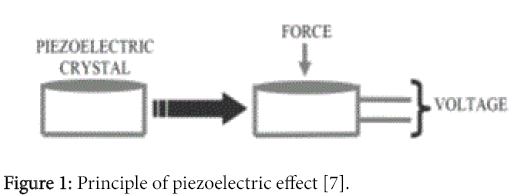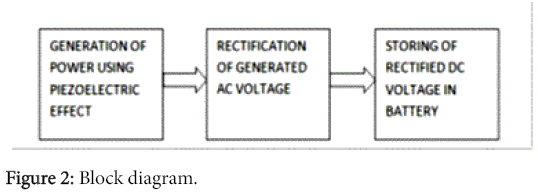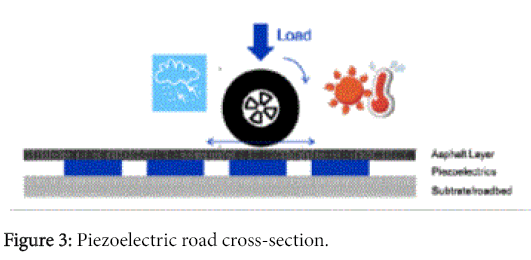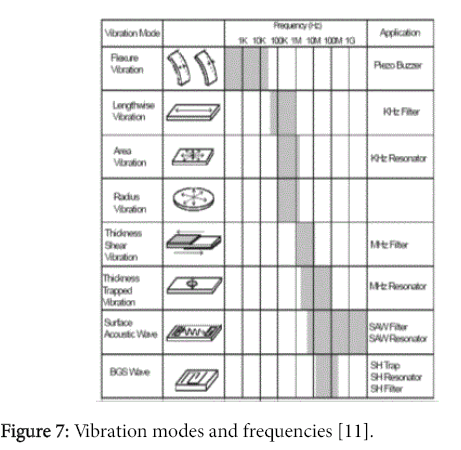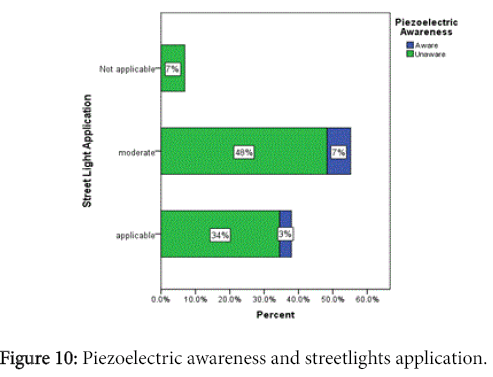Piezoelectric Roads: Energy Harvesting Method Using Piezoelectric Technology
Received: 31-Dec-2015 / Accepted Date: 22-Mar-2016 / Published Date: 25-Mar-2016
Abstract
This article aims to assess the functionality of piezoelectricity in roads to utilise energy executed from the moving vehicles. The energy is converted into electrical energy using piezoelectric technology to replace fossil fuel in streetlight applications. The vitality of this technology arises as fossil fuels is being over consumed which makes it challenging to provide sufficient power in the next era as an effect of growing population. Being dependent on renewable energy to account for a greater global consumption level is essential to overcome the risks associated with fossil fuels. Piezoelectric road is a new energy evolution to provide a sustainable solution in terms of environment, economy, and social needs.
Keywords: Piezoelectric roads; Piezoelectric technology; Energy harvesting roads; Renewable energy
18591Introduction
Fossil fuel phase out
As the demand of fossil fuel is enormously increasing over time, the future of generating power using non-renewable energy will come to a halt. This overconsumption and risks associated is pressuring the environment and economy as well. In 2004, the global energy consumption level of non-renewable energy has risen to 80%, and will remain increasing in the next 20-30 years due to population growth as a main factor.
This level results in a drastic amount of CO emissions and greenhouse gasses being pumped into the air raising concerns on rising sea levels, increasing average temperature, and extreme weathering conditions. The increase of energy demand will cause a price increase on fossil fuel contributing to tax policies and thus higher electricity bills to end users. The major issue is that fossil fuels used to supply energy to feed recent generation are by one word, exhaustible [1]. On the other hand, if energy consumption continues growing, then meeting future energy demand is challenging. Phillips and Mighal [2] claims that energy extracted from fossil fuels are being consumed 100,000 times faster than they are being formed. He also discuss fossil fuel resources, targeting oil and gas, are expected to get depleted in the end of 21 century [2].
As stated in IISD Report the G7 countries, a group of finance ministers and central bank governors, agreed to phase out the usage of oil, gas and coal at the end of 2100 [3]. This form of agreement seeking for sustainable solutions made by leading countries offers a green light to great investments opportunities around the globe. Sustainability is simply a shortcut to a long term profit earnings and an incentive towards harnessing the “greenies” to expand and produce clean-energy products [4].
Piezoelectric technology
Redirecting routes to integrate the principle of piezoelectric devices to urban roads is significant, at this stage. Focusing on the transition of energy to piezoelectric integrated roads, a renewable energy harvesting method, will lead the next power generation into a feasible and more reliable source of energy.
The term Energy Harvesting or Renewable Energy, such as solar panels or wind turbine, is a method of producing electrical energy by utilizing the energy surrounding the environment from the sun and wind, for example [5]. However, energy formed from various vibration machines, objects in motion, or any other source of mechanical energy is not being captured. Therefore, this source of energy is dispersed and thus wasted. As an effective method to utilize this loss, piezoelectric material is used to absorb the wasted mechanical energy and convert it to electrical energy [6].
Piezoelectric working principle
The principle of piezoelectricity lies behind the crystals. As shown in Figure 1, electrical voltage is induced when crystalline materials are subjected to external force, pressure, or strain. There are several types of natural crystals, found at the surface or deep within the earth, which can be used today to apply piezoelectricity effect such as clear quartz and amazonite. A variety of artificial crystals are formed by chemical compounds, as well. These include Barium Titanate, Lead Titanate, and Lead Zirconate Titanate, etc. [7].
Figure 1: Principle of piezoelectric effect [7].
The efficiency of piezoelectric devices is influenced by the type of crystals due to the variety of their properties. However, Lead Zirconate Titanate (PZT) crystals are being used widely to achieve a high piezoelectric effect. The ease of fabrication to any complex shape, high material strength and long-life service, resistant to humidity and heat temperature over 100°C, are all distinctive factors of PZT [8]. In addition to crystalline material suggested, Table 1 shows other parameters that play a major role to determine the best outcomes of piezoelectricity [6].
| Geometry | The most efficient form to produce more energy is tapered shape |
| Thickness | More energy is produced with thinner material |
| Loading Mode | More energy is produced with increase in mass or force |
| Fixation | Fixation at one end will result in more deflection, thus more energy when subjected to external force, than when fixed at two ends |
| Structure | Bimorph structures produce double the energy output than unimorph structure |
Table 1: Piezoelectricity parameters.
The basic diagram shown in Figure 2, illustrates piezoelectricity undergo certain process prior to energy output. AC voltage is generated as pressure or force is exerted on piezoelectric device. The generated voltage is then adjusted and converted into DC voltage and stored in batterieML or capacitors for electric application purposes [9].
Street lightening using piezoelectric roads
Piezoelectric crystals can be embedded underneath the asphalt layer to utilize the energy generated due to the vehicle motion, as illustrated in Figures 3 and 4. As the vehicles move over the asphalt layer, the wheels exert a force or pressure into the crystals and thus deform. This deformation will absorb the force and undergo the process of power generation, as shown above, to be stored in batteries [10]. The use of storage is essential at this stage, since street lights are operated for 12 h per day. Therefore, the energy can be dispersed when required.
Figure 4: Cross-sectional diagram of the roadway [12].
Energy Generated: Power asphalts used to provide electrical power to street lights was tested in Hefer intersection, Israel. The set up involved piezoelectric devices lay beneath asphalt roads, at a total distance of 10 m only. The setup has generated electrical power of two Kilowatt-Hours (KWh) [11]. Another test has been conducted by POWERleap, a licensed technology manufacturer, has provided a data proving the reliability of power asphalts. The experiment involves 1 Km stretch power asphalt with vehicle passing rate of 200-400 in 16 h. Based on this experiment, the total electrical energy generated range between 400 KWh - 600 KWh [12]. The revealed as a main source of energy as it saves cost and reduces fossil fuel consumptions.
Table 2 compares street light cost in UK, provided that the standard electricity cost in United Kingdom is 0.15 GBP/KWh in 2014 [13], with POWERleap data, A typical mercury light street wattage can reach to a maximum of 500 W [10]. Assuming there are 10 individual street lights.
| Cost(GBP)/KWh | Street lamp kilowatt(KW) | Time in hours /Day | Street Lamp No. | |
| 0.15/KWh | 0.5 KW | 12hours/day | 10 | |
| Cost /day of 10 lamps=0.15/KWh×0.5KW×12hours/day×10 lamps=9 GBP/day | ||||
| Power leap scenario data | ||||
| KWh generated | Cost(GBP)/KWh | |||
| 400 KWh | 0.15/KWh | |||
| Free cost power asphalt generated= | 400 KWh×0.15/KWh=60GBP | |||
Table 2: Street light electricity consumption comparison.
According to the data calculated above, approximately 90 pennies is required to power one street light using fossil fuels in one day, or 12 h duty. Cost increases into 9 GBP when 10 lights are used. For the same electricity cost provided by the UK government, power asphalts will save 60 GBP which is sufficient to power 10 street lights for 6 days, or 12 h per day. And by using the standardized energy conversion unit given in appendix D, 400 KWh having a free bill of 60 GBP is equivalent to save 8.598 tonnes of oil equivalent [14].
Other data of different vendors shown in Table 3 were combined in a report, Assessment of Piezoelectric Materials for Roadway Energy Harvesting, discussing outcomes of generated electricity. Vendors include Genziko, ODOT, Innowattech, Berkeley and Virginia Tech [12].
| Parameter | Genziko | ODOT | Innowattech | Berkeley and Virginia Tech |
| Power per km (single lane) |
13-51 MW | 486 kW | 100-200 kW | 0.0018-0.5 kW |
| Vehicles per hour (single lane) |
600-2250 | 600 | 600 | 600 |
| kW per km per vehicle per hour | 21.6-22.6 | 0.81 | 0.16-0.3 | .000003-0.00083 |
Table 3: Power metrics by vendors [12].
The vendors share different power obtained. The metric used to describe power asphalt is Power/km. As shown, the generated power is of very varying results. The Power executed by Genziko of 13 MW - 51 MW in total with passing vehicles rate 600-2250 per hour, create a huge difference with POWERleap and the remaining vendors. This power obtained in a short 1 Km span is enough to generate lights for years.
Several parameters were considered by all vendors. These include vehicle weight, vehicle speed, and capacity flow of vehicles. However, they cannot be controlled in real life environment. A distinguished parameter used by Genziko is power pulse width. The only parameter controlled by technology, enabling piezoelectric power output to quantify. These simple but very effective parameters have been neglected by ODOT, Innowattech, Berkeley and Virginia Tech [12].
Power Pulse Width: From the data observed by Berkley in Table 3, it is concluded that power asphalts is a very challenging technology as energy harvester. But the lack of implementing the technology of recent engineering innovation failed to maximize power density [12]. The output of power density is related to the frequency (Hz) and it has been verified that piezoelectric devices can operate in very high frequencies [15]. Having high frequencies enable piezoelectric devices to isolate in a wider range generating more total power output. In other words, long-lasting frequency or decaying vibrations continues to generate power as a result of initial impact. Genziko applied the same principle of micro-cantilever array beams, as illustrated in Figures 5 and 6. Stacked arrays result in a higher power initially with single vibration, but are very low compared to decaying arrays [12].
Piezoelectric devices can further be optimized by manipulating over the shapes as discussed. Several shapes introduced in Figure 7 generate different vibration modes. These modes create different range of very high frequencies which in turn widen the decaying phase even further [11].
Figure 7: Vibration modes and frequencies [11].
Other factors affecting piezoelectric road efficiency
Vehicle speed: Gupta et al. [15] state that vehicles moving slowly appear to generate slightly more energy than faster-moving vehicle. In contrary to DNV Kema, energy efficiency always increases with more speed. Different types of vehicles such as bus, car, and motorcycle were tested at a speed of 45 mph and 65 mph. Power output is always greater with higher speed [12]. Higher speed has a higher impact on frequency resulting in a higher decay.
Vehicle weight: Simply put, the higher the force exerted the more deformation of crystals and thus higher energy produced. The same principle applies for vehicles; a truck will generate more energy than light duty vehicles and motorcycles [12].
Traffic flow capacity: Upon implementing such technology, this parameter would be first considered. The overall technology performance will certainly provide less energy if power asphalts are designed in areas were less frequent vehicles cross over. It is suggested to apply power asphalts on busy roads were a reasonable number of vehicle capacity flow. Planning the location of power asphalt is an essential decision to meet energy needs [10].
Data Collection
Knowing the principle behind piezoelectricity and falling under renewable energy category has drawn expected results. Renewable energy provides a wide range of methods to utilize lost energy in the environment. Yet, they are not enough to completely depend upon to account for a higher consumption. These methods lack the ability to harvest one of the ambient lost energy which is exerted mechanically.
Apart from emitting zero carbon emissions, respondents were highlighted to piezoelectric functionality and the ability to transform mechanical to electrical energy. This clean method grabbed attention of 73 percent, as shown in Figure 8, respondents to emerge piezoelectricity with other renewable methods and thus increase its future application.
Limited piezoelectric expertise: almost 90% of the respondents of engineering background and profession were unaware of piezoelectricity. This result is logical compared to other renewable energy that are spread and used extensively in energy harvesting for application purposes. Especially for wind turbines and solar panels that account for 97% of respondents’ awareness each, having observed to best provide the required efficiency on field among remaining methods being used today (Figure 9).
Regardless of the lack of knowledge observed by respondents on piezoelectric devices used in road application, the results obtained in terms of street light applications hold a promising relation of hypothesis to link secondary data, but observations were unexpected. This is evident by the fact that only 7% of the respondents perceive power asphalt is not a reliable method to replace fossil fuels in street lights applications, which is relatively very low rate. The same graph has been divided to separate groups, which splits respondents having knowledge of piezoelectricity from unaware respondents. This is set to measure the validity of answers provided by respondents based on their knowledge. Furthermore, to support the null hypothesis of this research (Figure 10).
Application
However with the analysis observed, results are not taken for granted to comply with the original hypothesis. Respondents engaged in this study employed an error variable which might fail the hypothesis. Having 34% of the respondents unaware of piezoelectricity to support research hypothesis develop misleading information. In addition to 48% respondents which generates a higher deviation away from the proven hypothesis. The data is granted for only 3% to have power asphalts in terms of street lights application.
Chi-test Statistical Approach: To further ensure bias answers provided by the respondents, a chi-test is used to have a precise measure of the percentage error by respondents. This analysis determines the significance of respondents answered by chance based on their piezoelectric awareness and power asphalt principle variable. For a valid data, the significance level must fall under 0.005% or 5% probability for this research. However, the chi-test table provided according to table count shows insignificant results and thus fails to support the proven hypothesis of power asphalt reliability. In other words, the likelihood to have answered the power asphalt reliability is 56% by chance, as shown in two sided Pearson chi-square. This percentage deviates critically from the significant level of 0.05 which concludes unreliable results given by respondents and thus failure to support hypothesis.
Case Study: Israeli roads using piezoelectricity
In 2009, the Ayalon, Coastal, and Trans-Israel Highway were embedded with piezoelectric devices 5 cm below road level to test its efficiency in terms of electrical energy supplied by the moving vehicles. This test was proposed by an Israeli company named Innowattech that specializes in improving green methods to harness waste energy using piezoelectricity. The project was set to test a one km stretch of a single and four lane road integrated with piezoelectricity (Table 4). The results meet the required amount of energy in which 200 KWh for a single lane and one MWh on four lanes were generated at that time [12].
| value | df | Assymp.Sig. (2-sided) |
|
| Pearson Chi-Square | 1.155* | 2 | 0.561 |
| Likelihood Ratio | 1.9 | 2 | 0.387 |
| Linear by Linear | |||
| Association | 1.073 | 1 | 0.3 |
Table 4: Chi-square test.
Limitations
1. Piezoelectric road integrated technology is a new energy evolution and hence piezoelectric awareness and expertise in this sector are very limited. This was also observed in primary data collected using questionnaires and interview to have obtain invalid and bias information.
2. The power metrics provided by vendors does not provide additional technical details. The vendors were compared using vibration-based factor only. Other technical factors were not analysed in terms of piezoelectric geometry, structure, and thickness that are mentioned in Table 1. This is common having not to reveal a full technical report of this technology to preserve innovation, invention rights and securitise effective business strategies.
3. Implementing piezoelectric road technology on field requires a standard specification in the execution process which has not been established. This is important as to use appropriate management and method to prevent manipulating with road infrastructure and minimize traffic congestion.
Conclusion
Having met the power metrics will make such invention a starting point to self-sustaining environment by being dependent on vehicle elements to curb down input energy and cost. This will be a revolution in the production of energy by meeting innovations and technologies to shape future energy. However, further concentration is required to quantify and result in a greater power outcome to become a reliable source of electricity.
Acknowledgement
This project expended tremendous measure of work, research and commitment. Yet, this paper would not have been conceivable in the event that we didn't have a backing of individuals from Coventry University, UK. Hence I would like to extend my true appreciation to every one of them.
This project was mainly supported by Dr Ravjeet Kour who provided proficiency and expertise that greatly aided the research and also provided valuable comment recommendations on this which gave me a motivation to enhance this paper. I also thank Mr Godfried Asante for assistance with guidance to research methodology, and Mr Vinnay Reddy for comments that greatly improved the manuscript.
Nevertheless, I express my thankfulness toward my family for their kind collaboration and encouragement to seek knowledge on demand and crave for education which helps me in completion of this project.
References
- Phillips M, Mighall T (2013) Society and Exploitation through Nature. Routledge, USA.
- Harris M, Beck M, Gerasimchuk I (2015) IISD Report on The End of Coal: Ontario’s coal phase-out. Canada: International Institute for Sustainable Development.
- Hickson K (2013) Race for Sustainability: Energy, Economy, Environment and Ethics. Singapore.
- Songsukthawan P, Jettanasen C (2015) Performance Analysis of Maximum Power Transfer in Piezoelectric Energy Harvesting. Proceedings of the International Multi Conference of Engineers and Computer Scientists 2: 670-673.
- Ibrahim S, Ali W (2012) Power Enhancement for Piezoelectric Energy Harvester. Proceedings of the World Congress on Engineering 2: 1018-1023.
- Dikshit T, Shrivastava D, Gorey A, Gupta A, Parandkar P, et al. (2010) Energy Harvesting via Piezoelectricity. International Journal of Information Technology 2: 265-270.
- Nelson W (2010) Piezoelectric Materials: Structure, Properties and Applications. New York: Nova Science Publishers.
- Kalyanaraman K, Babu J (2010) Power Harvesting System in Mobile Phones and Laptops using Piezoelectric Charge Generation. Proceedings of the World Congress on Engineering and computer science 2: 879-882.
- Kumar P (2013) Piezo-Smart Roads. International Journal of Enhanced Research in Science Technology & Engineering 2: 65-70.
- Arjun M, Sampath A, Thiyagarajan S, Arvind V (2011) A Novel Approach to Recycle Energy Using Piezoelectric Crystals. International Journal of Environmental Science and Development 2: 488-492.
- Hill D, Agarwal A, Tong N (2014) Assessment of Piezoelectric Materials for Roadway Energy Harvesting. DNV Kema.
- Department of Energy and Climate Change (2014) Average variable unit costs and standing charge for standard electricity in 2014 for UK regions.
- Gupta M, Suman, Yadav SK (2014) Electricity Generation Due to Vibration of Moving Vehicles Using Piezoelectric Effect. Advance in Electronic and Electric Engineering 4: 313-318.
Citation: Kour R, Charif A (2016) Piezoelectric Roads: Energy Harvesting Method Using Piezoelectric Technology. Innov Ener Res 5: 132.
Copyright: ©2016 Kour R, et al. This is an open-access article distributed under the terms of the Creative Commons Attribution License, which permits unrestricted use, distribution, and reproduction in any medium, provided the original author and source are credited.
Share This Article
Recommended Journals
Open Access Journals
Article Usage
- Total views: 77789
- [From(publication date): 6-2016 - Apr 05, 2025]
- Breakdown by view type
- HTML page views: 72536
- PDF downloads: 5253

